Panel 1
Andrea Bianco, Saverio Devoti, Sara Morucci, Gabriele Nardone, Arianna Orasi, Luca Parlagreco, Marco Picone, Giulio Settanta
Upwelling is a physical phenomenon caused by the action of wind and currents that can generate an upwelling current, oriented offshore and perpendicular to the coast. This phenomenon has a significant impact on the local fish fauna and is therefore of great interest. The identification of the most favorable areas for the occurrence of this phenomenon has been carried out using wind speed and direction data provided by the National Tide Gauge Network (RMN) managed by ISPRA. These data, appropriately processed, allow the identification of coastal areas that are most likely to be exposed to the upwelling phenomenon, such as the Carloforte area in Sardinia, which is confirmed to be among the most favorable for the generation of this variable.
Coastal upwelling is a current phenomenon strongly influenced not only by marine currents but also by the intensity and direction of the wind along the coast. Specifically, the wind blowing parallel to the coast can have the effect, under certain conditions, of generating a current that is deflected by the Coriolis force, in a direction perpendicular to the coast and offshore. Upwelling is precisely the vertical current phenomenon that moves deeper, colder waters to replace the surface water dragged offshore by the wind. The carrying current, which originates mainly due to salinity variations, tends to bring water up from the bottom, water that is colder than that near the surface and rich in nutrients. This phenomenon has a significant impact on the local fish fauna. Upwelling is an extremely interesting phenomenon for identifying coastal areas with high nutrient concentrations and consequently increased local fish fauna. Upwelling phenomena have a significant influence on the recirculation of plankton-rich waters. Fish and marine organisms benefit greatly from this; it results in a significant increase in fish diversity and the fishery productivity of the sea area affected by the phenomenon. Due to the strong influence of the wind in generating the upwelling phenomenon, the identification of the most favorable areas for the development of this process was carried out by calculating the frequencies of windy events in a direction parallel to the coast using data from the tide gauge stations of the National Tide Gauge Network. Specifically, hourly wind data were used for those stations that had a sufficiently high number of recorded data; wind episodes within a 30-degree arc centered around the direction parallel to the coast at the point of interest, and with an intensity greater than 3 m/s, were selected.
To identify sea areas favorable to the occurrence of the phenomenon and, therefore, where a higher concentration of fish fauna is reasonably expected.
There are no regulatory references or objectives set by the legislation.
Panel 2
Bakun, A. 1973. Coastal upwelling indices, west coast of North America, 1946-71. U.S. Dep. Commer., NOAA Tech. Rep., NMFS SSRF-67.
D’Ortenzio, F., D. Iudicone, C. de Boyer Montégut, P. Testor, D. Antoine, S. Marullo,R. Santoleri and G. Madec (2005). Seasonal variability of the mixed layer depth in the Mediterranean Sea as derived from in situ profiles. Geophysical Research Letters, 32, L12605, doi:10.1029/2005GL022463.
Ekman, V.W. 1905. On the influence of the earth’s rotation on ocean currents. Ark. Mat. Astron. Fys. 2(11):1-52.
Fong, D. A. and Geyer, W. R.: Response of a river plume during an upwelling favorable wind event, J. Geophys. Res., 106, 1067–1084, 2001. 4.
Inghilesi, R. , L. Ottolenghi, A. Orasi, C. Pizzi, F. Bignami, and R. Santoleri, Fate of river Tiber discharge investigated through numerical simulation and satellite monitoring, Ocean Sci., 8, 773-786, 2012.
ISPRA - RMN Stations: www.mareografico.it
Magaldi, M. G., T. M. Özgökmen, A. Griffa and M. Rixen, On the response of a turbulent coastal buoyant current to wind events: the case of the Western Adriatic Current, Ocean Dynamics, Volume 60, Number 1 (2010), 93-122.
Massetti L., 2004, Identificazione e Analisi degli Upwelling in Area Mediterranea, Tesi di Master in Meteorologia applicata, Facoltà di agraria, Università degli studi di Firenze.
Millot, C., Circulation in the Western Mediterranean Sea, Journal of Marine Systems, Volume 20, Issues 1–4, April 1999, Pages 423–442.
The upwelling indicator requires an in-depth study of the correlation with onshore and offshore Sea Surface Temperature (SST) data.
Defining a more robust and achieved upwelling index by combining wind and SST data from remote sensing. The actions to be planned concern, in particular, the introduction of data obtained from the scatterometers, the data of Ocean Color and / or data from atmospheric numerical models.
Data quality assessment
ISPRA
The data are present in the database of the National Tires Network and can be found at www.mareografico.it or in Linked Open Data (LOD) at ISPRA - Dataset: http://dati.isprambiente.it/dataset/rmn-la-net-net-mallographic-national/
Italian seas
2019-2023
Indicator assessment
: First, statistical distributions and corresponding wind roses were created at each station of the National Tide Gauge Network (RMN) ISPRA, using wind speed and direction data from January 1, 2023, to December 31, 2023. Wind speed and direction were selected to identify the areas most favorable for the occurrence of the upwelling phenomenon. To account for the Coriolis force, directions parallel to the coast were chosen in the Northwest sector for the Tyrrhenian Sea and in the Southeast sector for the Adriatic Sea. Each directional sector has a width of 30°. Additionally, only winds with an intensity greater than 3 m/s were chosen. For each station, the ratio between the number of selected events (according to the procedure described above) and the total number of recorded data was calculated, obtaining an upwelling frequency (expressed as a percentage) that allows identifying the coastal areas most potentially exposed to the phenomenon.
The indicator allows the characterization of areas favorable to the occurrence of the upwelling phenomenon, without directly indicating a quantification. The update of the indicator with 2023 data highlighted a general stability in the number of favorable cases for the development of the upwelling phenomenon along the Italian coasts compared to 2022. As shown in Table 1, the stations in the Tyrrhenian area show very low frequencies of winds favorable to the generation of upwelling, while in the Adriatic Sea, these frequencies are generally higher, also thanks to the contribution of the Bora, a strong wind blowing from the Northeast that generates upwelling along the eastern coastline of the basin. The stations in the Ionian Sea and the Strait of Sicily indicate these areas as favorable for the generation of upwelling. A significant increase was recorded in 2023 compared to 2022 at the Porto Empedocle station. The Strait of Messina area is confirmed, as also known from literature, as an area strongly affected by upwelling mainly due to hydrodynamic phenomena, as the Ionian waters of the Strait are indeed colder than those of the surrounding basins. In 2023, moreover, compared to 2022, a further significant increase in winds favorable to the generation of upwelling was detected in the Ionian area near Crotone and a moderate decrease at the Ancona and Palermo stations. The station that generally indicates the most favorable area for the generation of upwelling phenomena is always Carloforte.
The analysis of the indicator starting from 2019 allows a preliminary evaluation of the short-term trend of the phenomenon, which appears generally stable. However, exceptions are observed at the Porto Empedocle and Crotone stations, where an increase in favorable cases for the generation of upwelling episodes seems to emerge over time. This trend requires further confirmation through the acquisition and analysis of new data.
Data
Table 1: Wind frequency along the Italian coasts
ISPRA – National Mareographic Network (RMN)
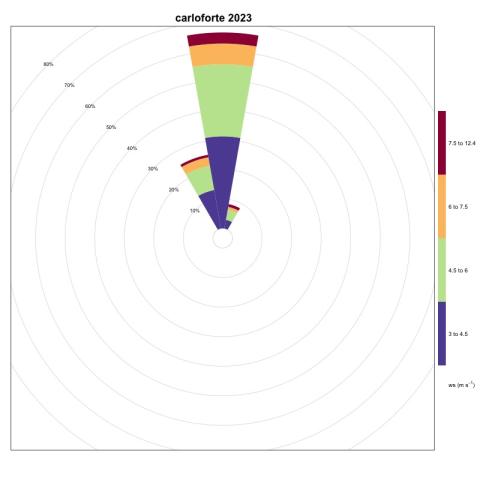
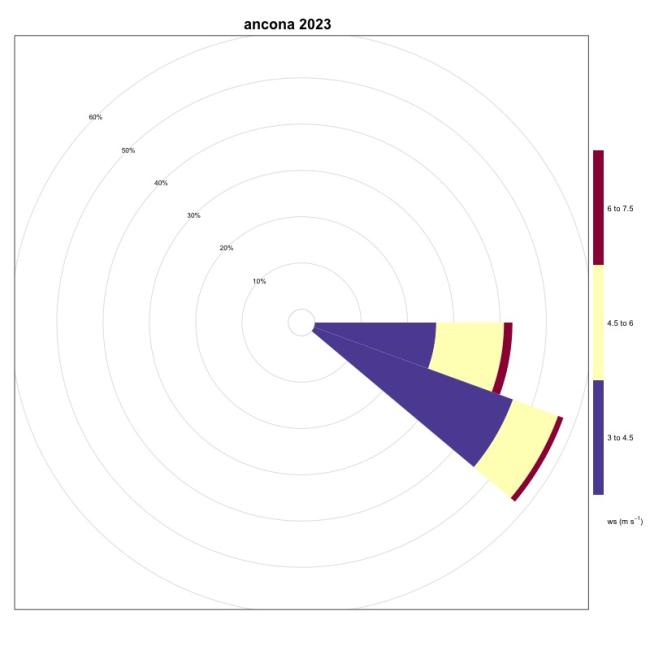
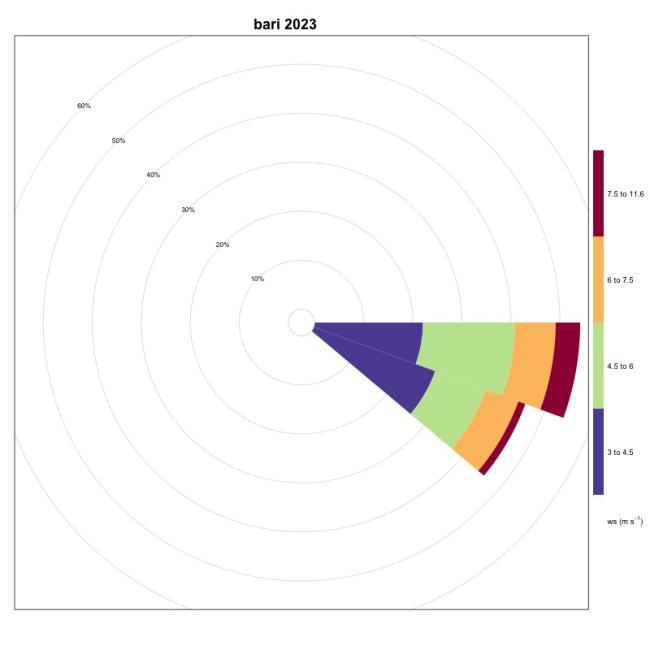
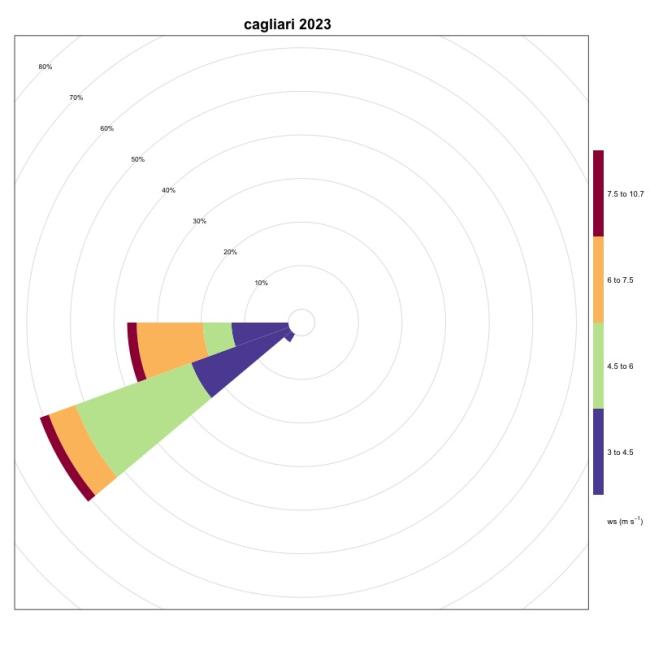
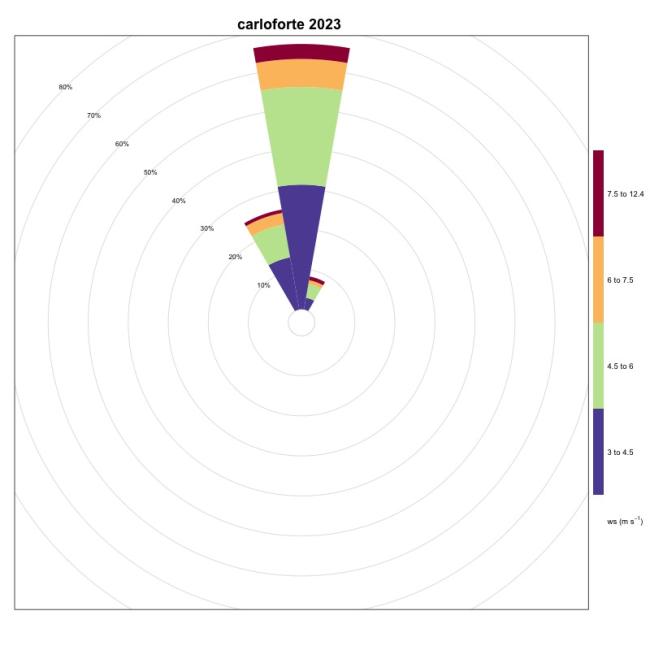
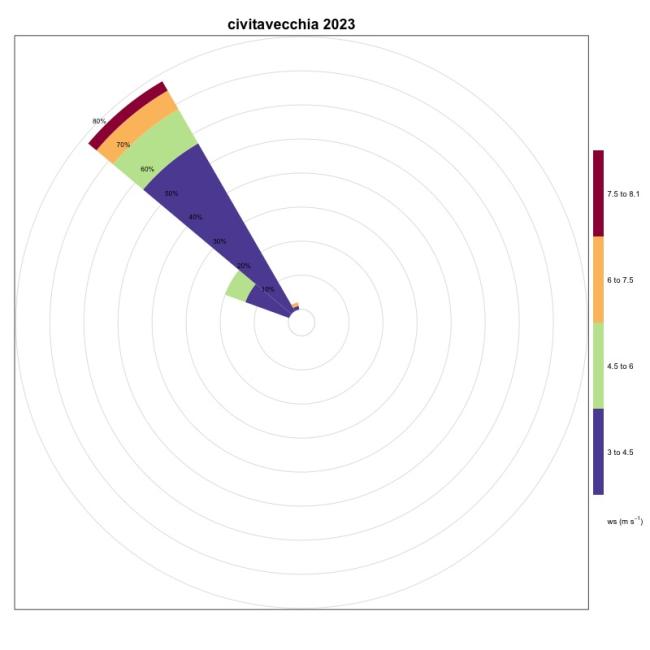
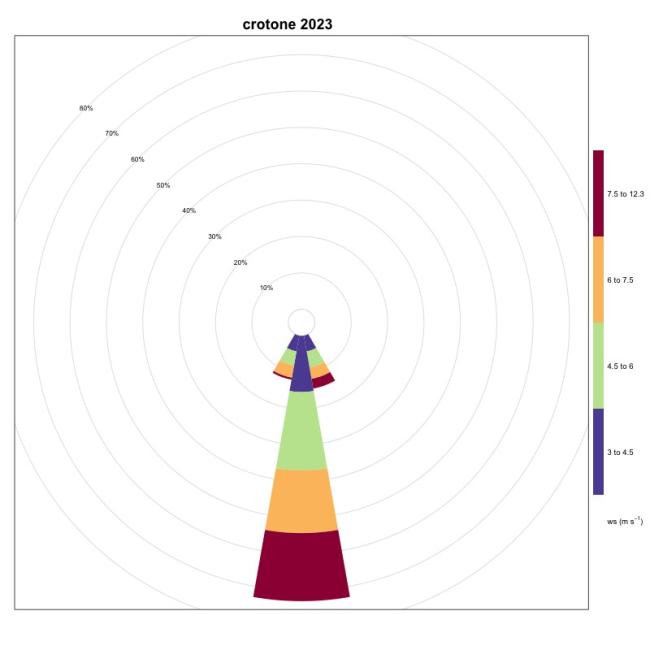
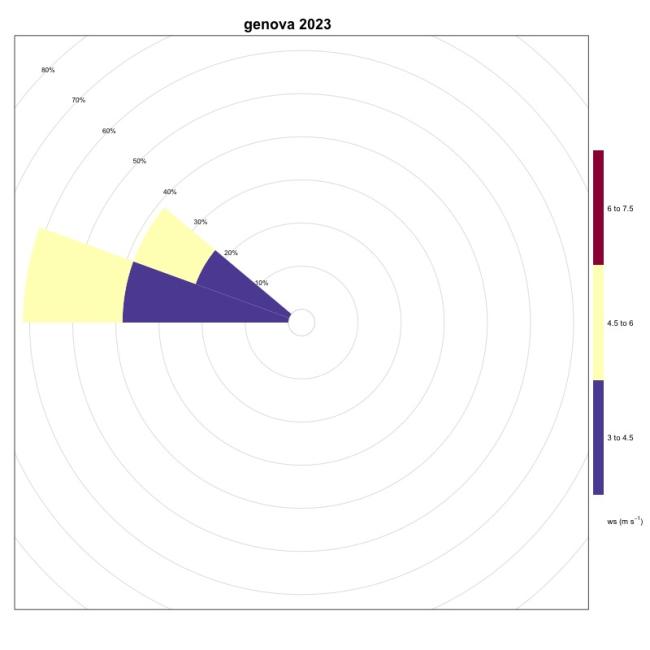
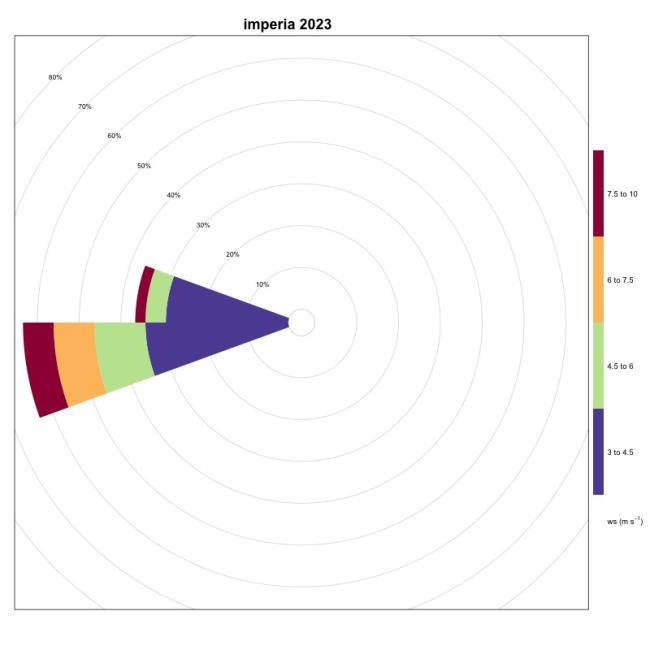
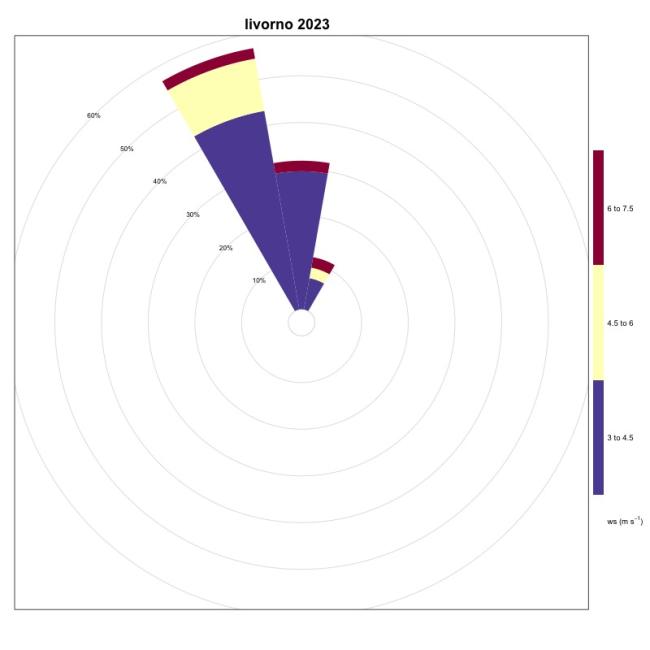
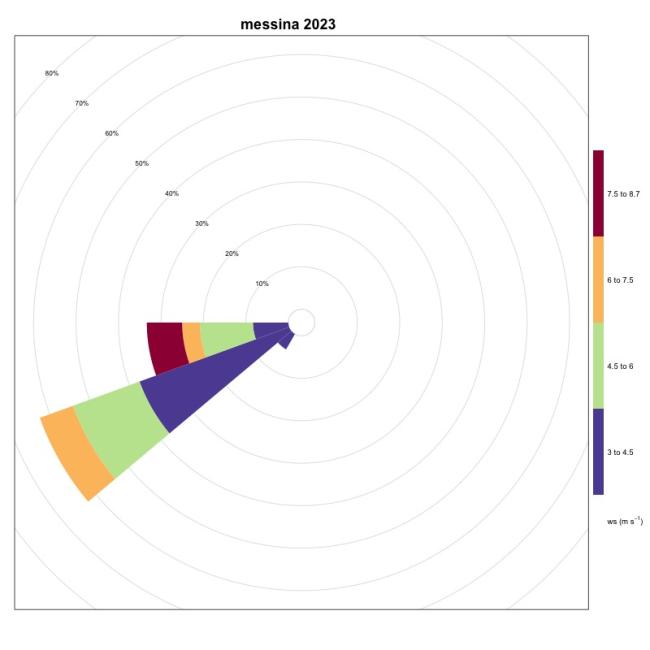
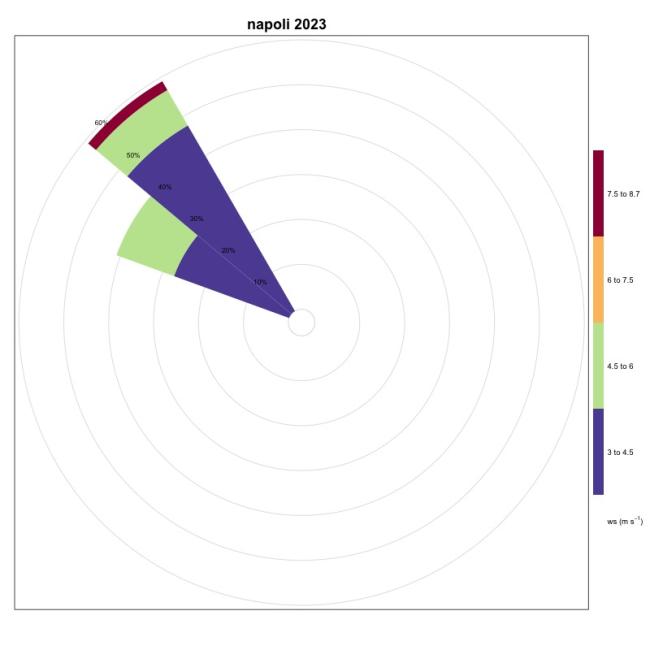
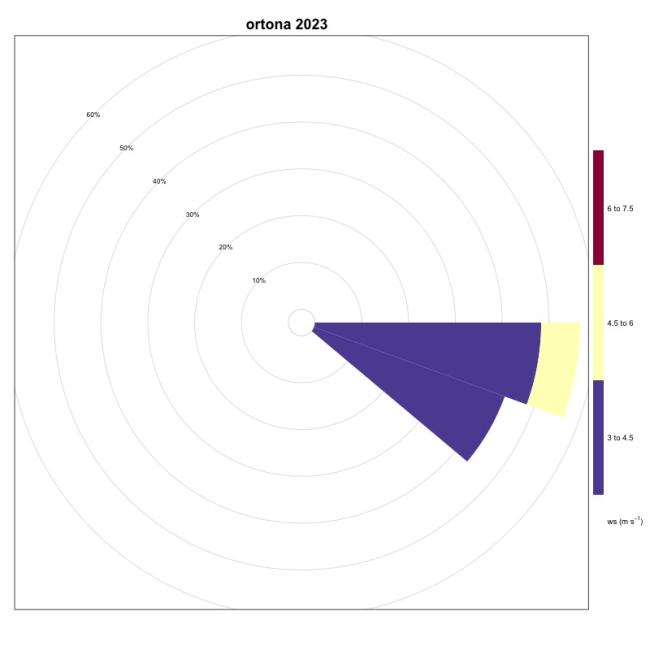
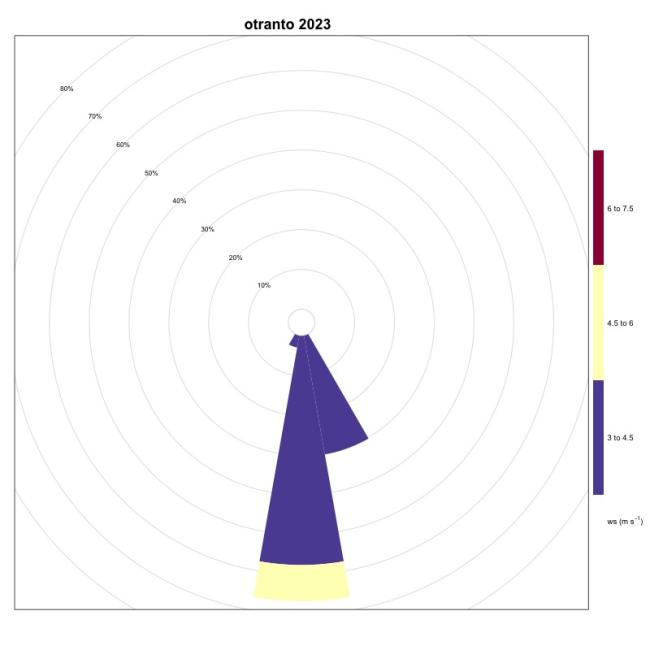
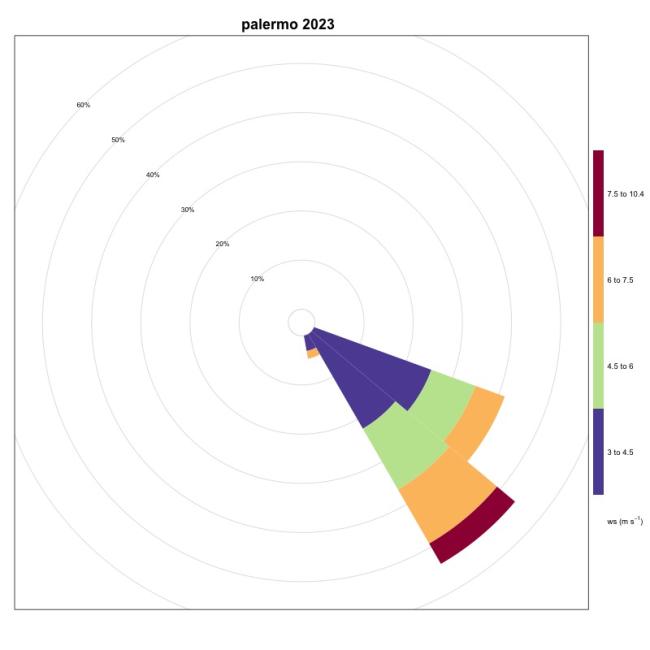
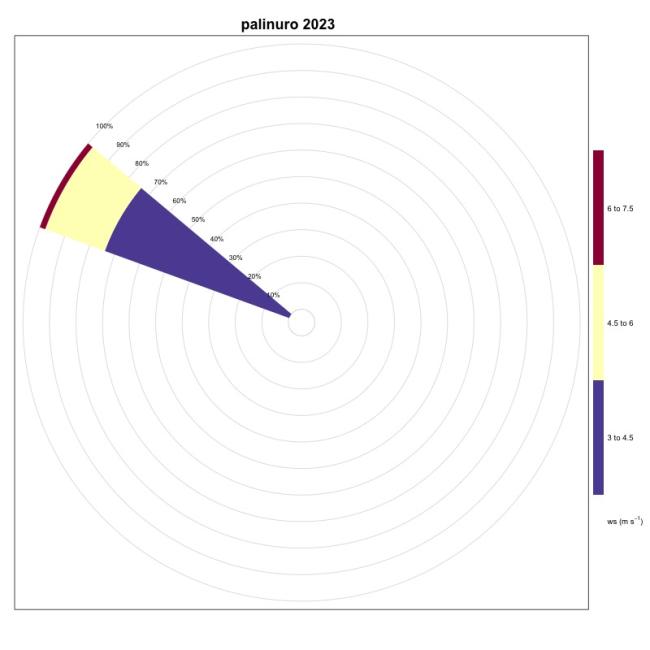
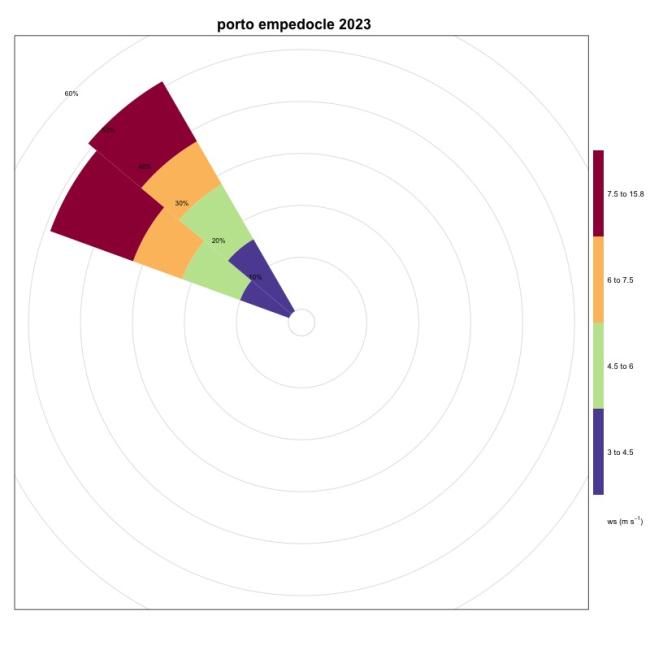
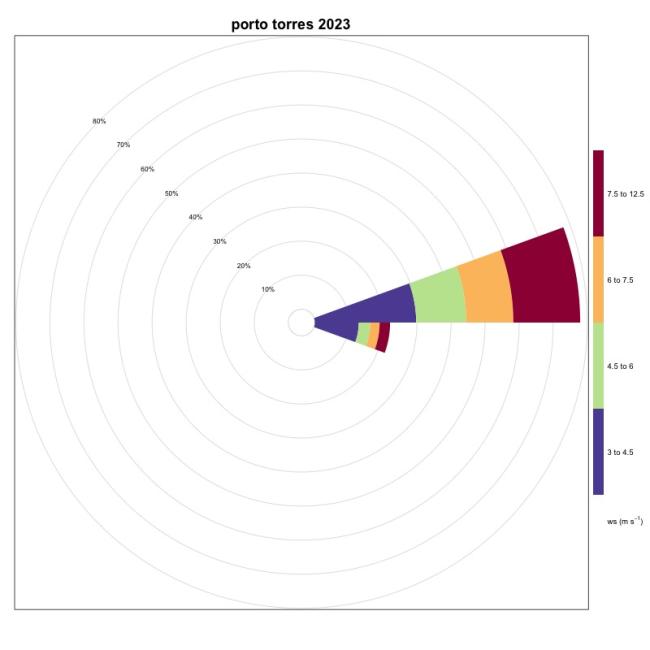
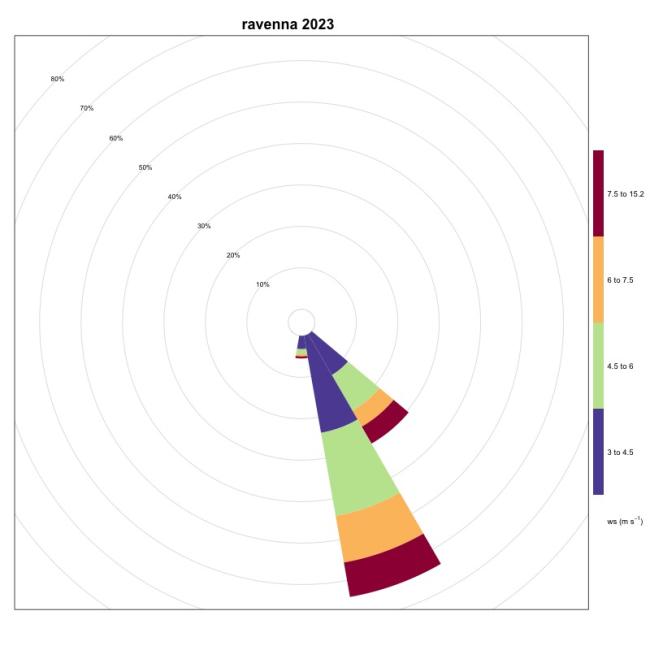
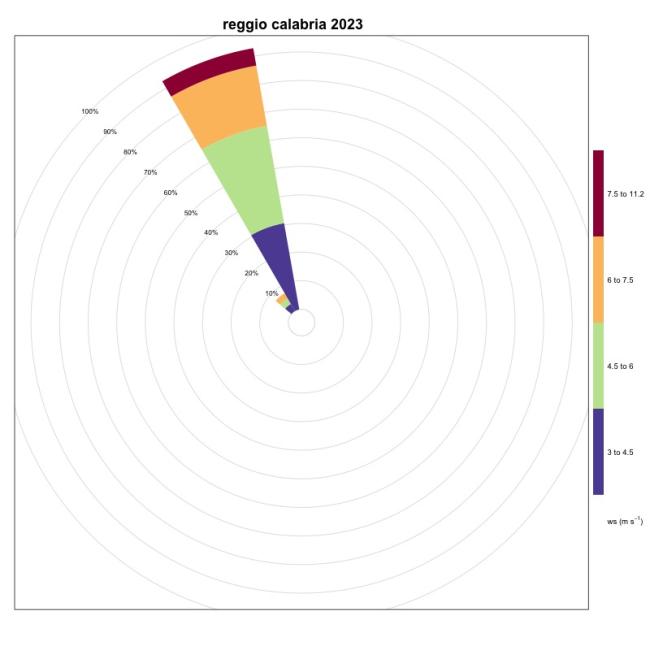
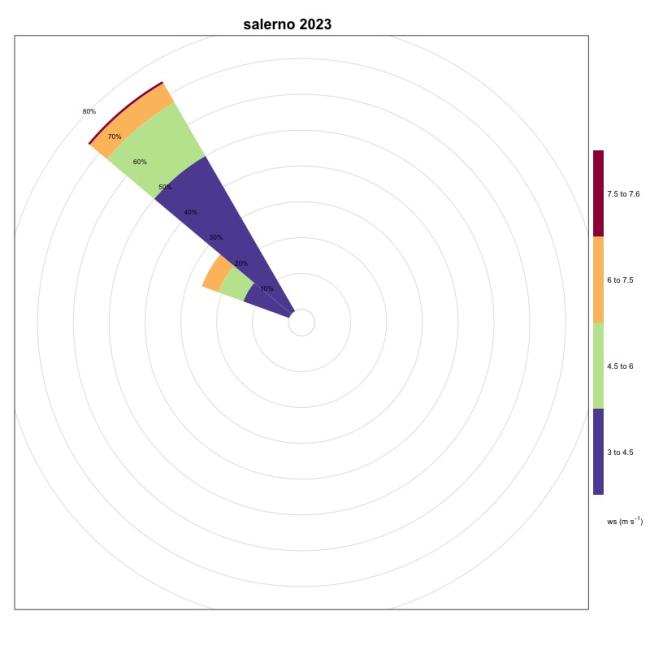

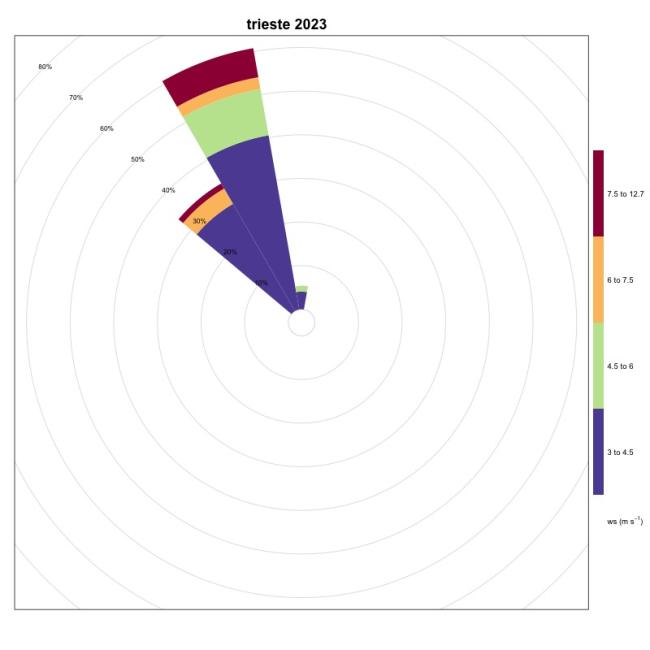
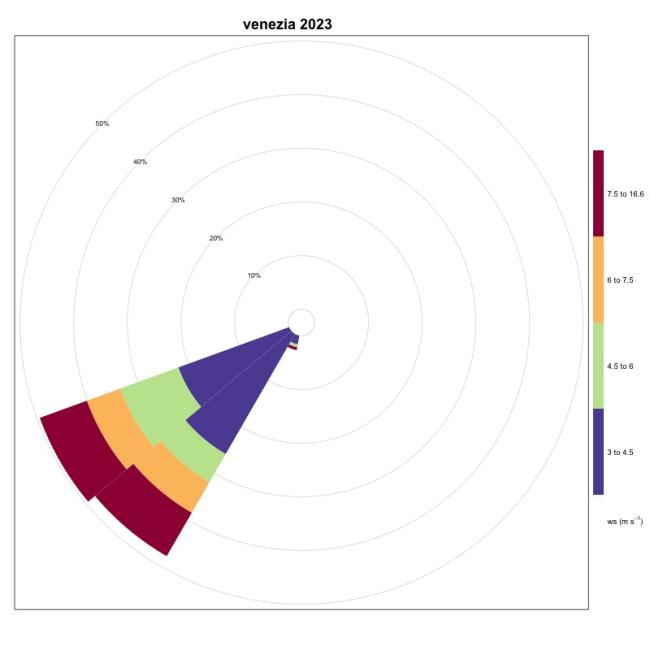
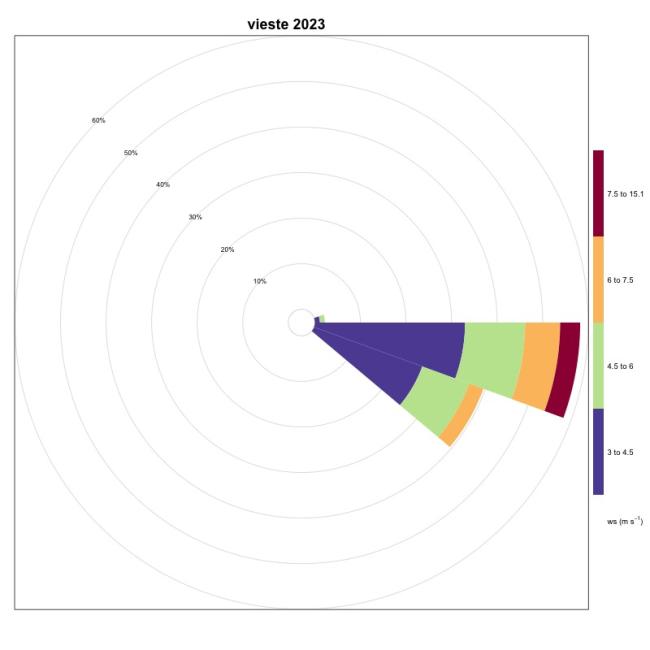
The resumption of maintenance of the National Tide Gauge Network (RMN) initiated in 2019 and managed by ISPRA has allowed the evaluation of the upwelling indicator for all stations in the monitoring network (Table 1). The stations considered in the western area of the Italian seas show wind directions favorable to the generation of upwelling phenomena predominantly from the North. Conversely, for the stations in the eastern area, predominantly from the South.
For the following stations, the selected directional sectors are (degrees N): Northern Tyrrhenian Sea:
The frequency of events for the stations of Imperia (Figure 9), Genoa (Figure 8), Livorno (Figure 10), and Civitavecchia (Figure 6) are respectively 0.47%, 0.15%, 0.50%, and 1.1%.
Southern Tyrrhenian Sea:
The frequency of events for the stations of Naples (Figure 25), Salerno (Figure 20), and Palinuro (Figure 15) are respectively 0.5%, 1.85%, and 0.52%.
The Adriatic Sea, in the northern area, is swept by the Bora, a strong wind blowing from the Northeast that generates upwelling along the eastern coastline of the basin. This stretch of sea is also affected by a large influx of river water from the Po and other major rivers of Northeastern Italy, characterized by lower temperature and salinity compared to the sea and higher nutrient richness.
The stations considered are:
The frequencies recorded in the northern area are respectively for Trieste (Figure 22), Venice (Figure 23), Ravenna (Figure 18), Ancona (Figure 1) 0.85%, 2.1%, 4.66%, and 1.88%. The frequencies in the southern part of the Adriatic, recorded at the stations of Ortona (Figure 12), Vieste (Figure 24), Bari (Figure 2), and Otranto (Figure 13) are 0.69%, 1.04%, 4.57%, and 0.38%.
The frequencies calculated in the Ionian Sea come from the stations of Taranto (Figure 21) and Crotone (Figure 7), with values of 1.75% and 10.16% and the following directional sectors:
The upwelling phenomenon in Sicily was calculated using data from the stations of:
The Catania station in 2023 experienced malfunctions starting from February, so it was not possible to calculate the percentage of favorable phenomena. The other two stations have frequencies of 6.95% (Figure 16) and 0.72% (Figure 14), respectively.
A particular case, due to the physical nature of local tidal and hydrodynamic phenomena, is represented by the Strait of Messina, monitored through the stations of:
where frequencies of 5.56% (Figure 19) and 0.28% (Figure 11) were recorded, respectively.
In Sardinia, finally, Cagliari (Figure 4) presents a percentage of events from the sector between 230° and 260° equal to 0.53%, Porto Torres (Figure 17) a frequency of 3.73% in the directional sector 75° – 105°, while Carloforte (Figure 3) with a frequency of 13.42% is once again the station with the highest number of favorable events, found in the directional sector between 345° and 15°.